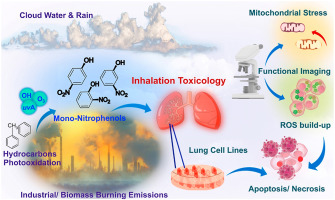Cytotoxicity and oxidative stress induced by atmospheric mono-nitrophenols in human lung cells
F. Khan, M. Jaoui, K. Rudzinski, K. Kwapiszewska, A. Martinez-Romero, D. Gil-Casanova, M. Lewandowski, T. E. Kleindienst, J. H. Offenberg, J. D. Krug, J. D. Surratt, R. Szmigielski
Environmental Pollution 301 (2022) 119010
Abstract
 Nitrophenols (NPs) are hazardous pollutants found in various environmental matrices, including ambient fine particulate matter (PM2.5), agricultural residues, rainwater, wildfires, and industrial wastes. This study showed for the first time the effect of three pure nitrophenols and their mixture on human lung cells to provide basic understanding of the NP influence on cell elements and processes. We identified NPs in ambient PM2.5 and secondary organic aerosol (SOA) particles generated from the photooxidation of monocyclic aromatic hydrocarbons in the U.S. EPA smog chamber. We assessed the toxicity of identified NPs and their equimolar mixture in normal bronchial epithelial (BEAS-2B) and alveolar epithelial cancer (A549) lung cell lines. The inhibitory concentration-50 (IC50) values were highest and lowest in BEAS-2B cells treated with 2-nitrophenol (2NP) and 4-nitrophenol (4NP), respectively, at 24 h of exposure. The lactate dehydrogenase (LDH) assay showed that 4NP, the most abundant NP we identified in PM2.5, was the most cytotoxic NP examined in both cell lines. The annexin-V/fluorescein isothiocyanate (FITC) analysis showed that the populations of late apoptotic/necrotic BEAS-2B and A549 cells exposed to 3NP, 4NP, and NP equimolar mixture increased between 24 and 48 h. Cellular reactive oxygen species (ROS) buildup led to cellular death post exposure to 3NP, 4NP and the NP mixtures, while 2NP induced the lowest ROS buildup. An increased mitochondrial ROS signal following NP exposure occurred only in BEAS-2B cells. The tetramethylrhodamine, methyl ester, perchlorate (TMRM) assay showed that exposed cells exhibited collapse of the mitochondrial membrane potential. TMRM signals decreased significantly only in BEAS-2B cells, and most strongly with 4NP exposures. Our results suggest that acute atmospheric exposures to NPs may be toxic at high concentrations, but not at ambient PM2.5 concentrations. Further chronic studies with NP and NP-containing PM2.5 are warranted to assess their contribution to lung pathologies.
Nitrophenols (NPs) are hazardous pollutants found in various environmental matrices, including ambient fine particulate matter (PM2.5), agricultural residues, rainwater, wildfires, and industrial wastes. This study showed for the first time the effect of three pure nitrophenols and their mixture on human lung cells to provide basic understanding of the NP influence on cell elements and processes. We identified NPs in ambient PM2.5 and secondary organic aerosol (SOA) particles generated from the photooxidation of monocyclic aromatic hydrocarbons in the U.S. EPA smog chamber. We assessed the toxicity of identified NPs and their equimolar mixture in normal bronchial epithelial (BEAS-2B) and alveolar epithelial cancer (A549) lung cell lines. The inhibitory concentration-50 (IC50) values were highest and lowest in BEAS-2B cells treated with 2-nitrophenol (2NP) and 4-nitrophenol (4NP), respectively, at 24 h of exposure. The lactate dehydrogenase (LDH) assay showed that 4NP, the most abundant NP we identified in PM2.5, was the most cytotoxic NP examined in both cell lines. The annexin-V/fluorescein isothiocyanate (FITC) analysis showed that the populations of late apoptotic/necrotic BEAS-2B and A549 cells exposed to 3NP, 4NP, and NP equimolar mixture increased between 24 and 48 h. Cellular reactive oxygen species (ROS) buildup led to cellular death post exposure to 3NP, 4NP and the NP mixtures, while 2NP induced the lowest ROS buildup. An increased mitochondrial ROS signal following NP exposure occurred only in BEAS-2B cells. The tetramethylrhodamine, methyl ester, perchlorate (TMRM) assay showed that exposed cells exhibited collapse of the mitochondrial membrane potential. TMRM signals decreased significantly only in BEAS-2B cells, and most strongly with 4NP exposures. Our results suggest that acute atmospheric exposures to NPs may be toxic at high concentrations, but not at ambient PM2.5 concentrations. Further chronic studies with NP and NP-containing PM2.5 are warranted to assess their contribution to lung pathologies.



